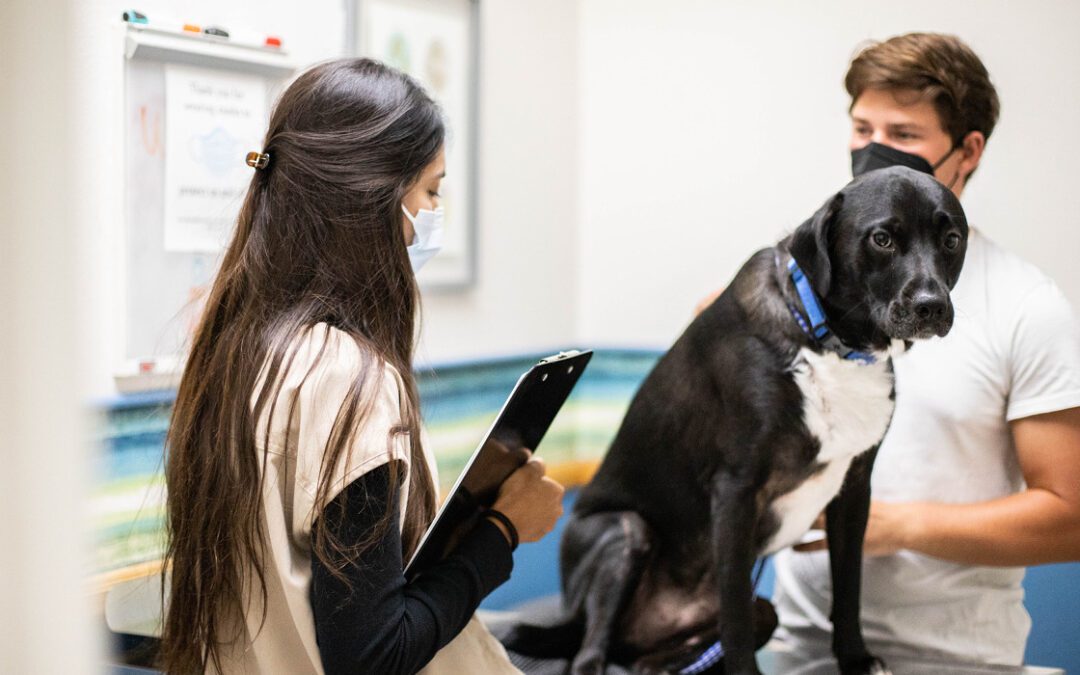Even though providing timely pet care is at the top of every veterinary professional’s mind, sometimes pet owners aren’t able to afford the services. According to Synchrony’s Lifetime of Care study, the estimated cost of caring for a dog for 15 years ranges from $19,893–$55,132, while lifetime care for a cat can cost between $15,055–$45,790.¹ This makes it clear that pet care is a long-term financial investment for pet owners, one that often comes with a range of emotions and tough choices to make. Thankfully, that’s where your veterinary practice can step in!
By educating pet parents on pet insurance and providing flexible financing options, your clinic can help alleviate the financial friction of veterinary care and ensure pets get what they need when they need it. We’re walking through the different paths your team can take to help pet owners navigate their own financial landscape, and how your practice can use empathy and financial education to guide clients toward making informed decisions about their pets’ health.
Why discussing money in your veterinary clinic matters
The conflict between cost and care can be challenging for everyone: veterinary teams hope their clients can afford their recommended treatments, and pet owners want what’s best for their pets without falling into massive amounts of medical debt. That’s why proactively talking about finances and offering solutions—like pet insurance and payment options—can help remove some of the financial pressure of veterinary care, allowing pet owners to focus more on their pets’ health journeys and less on their wallets.
Talking to pet parents about financial planning
Two key components when discussing finances with your clients are compassion and clarity. These can be uncomfortable conversations, so your team needs to take an approach that guides pet owners to make the decisions that best fit their budgets and their pets’ needs.
1. Provide educational resources and supportive materials
Your clients may be experiencing financial strain for a number of reasons. No matter what they may be going through, it’s important to offer flexible and budget-friendly payment options that make veterinary expenses easier to manage. One solution is the CareCredit credit card, which pet parents can use to spread out the cost of health and pet services while still giving their pets’ the care they need.
If your practice accepts CareCredit, be sure that your clients know about it. You can proactively spread the word using your custom veterinary website, customizable appointment reminders, and by letting pet owners know whenever they’re in the clinic (either verbally or with a printed handout). Anyone can use their mobile device to prequalify for CareCredit without impacting their credit score. Then, if they apply and are approved, a pet owner can make a payment right away in your clinic without waiting for their card to come in the mail. Offering convenient payment solutions like CareCredit—along with other educational materials that explain their financing options—can empower pet owners to make informed decisions without feeling overwhelmed.
2. Approach conversations with veterinary clients without judgment
Once your clients have a solid understanding of the payment options available to them, give them enough time and space so they can choose what they feel is best for their pets. Veterinary decisions can be extremely personal and emotional, and some pet owners may need more time than others to process the information you’ve provided. Always encourage pet owners to ask any questions at any time, and prepare your team members to discuss possible expenses in a supportive and transparent way.
See what PetDesk makes possible
Our solutions are designed to tackle your clinic’s specific challenges.
Set up time with a PetDesk expert to see for yourself!
Discussing pet insurance with pet owners
While popularity in pet insurance is on the rise (the North American Pet Health Insurance Association reports a 21.9% growth rate in 2023²), many pet owners remain skeptical about its true value. Educating your clients on how pet insurance works and its potential benefits can help them understand why it’s a worthwhile investment, especially when unexpected veterinary bills surface.
1. Clarify how pet insurance works
One common misbelief pet parents have is that pet insurance will limit which veterinarian they can take their pets to. You can reassure your clients that getting pet insurance won’t prevent them from continuing to see you for care, and that having insurance will actually help them more consistently afford your services. Aside from highlighting the benefits pet insurance can provide, it’s important to educate your clients on how pet insurance actually works. Explain to pet owners that pet insurance typically runs on a reimbursement basis, which means clients pay for the veterinary care upfront and then submit their invoices to their insurance provider who will then pay them back. Simply taking the time to make sure they understand how pet insurance works can help clear up any misconceptions and reduce concerns.
2. Help pet parents pick the right plan
It’s certainly not your job to select an insurance provider or plan, but guiding your clients in choosing coverage that meets their needs will make things easier on them and their pets’ health journeys. You can help pet owners understand that, since different pets have different health risks, insurance plans vary as well. For example, pet parents can choose anything from general coverage to more specialized options that come with emergency care, accidents, and wellness add-ons. Equipping them with basic insights and guidance can help them decide what type of insurance plan may be most beneficial for their pets’ lifestyles.
3. Highlight the benefits of combining financing options with pet insurance
Flexible payment options and pet insurance are convenient ways to help pet parents better manage the costs of their pets’ health journeys, but they can provide even more convenience when used together. You can remind your clients that pets are more likely to develop chronic conditions or need more costly procedures as they continue to age, so combining pet insurance with financing options like CareCredit can help manage these expenses even more efficiently. That’s because while a comprehensive insurance plan can offset many veterinary costs, financing options can cover expenses that insurance plans don’t, like co-pays or non-covered pet services. This combination of pet insurance and flexible financing provides pet owners with a more holistic approach that takes not only their pets’ health into consideration, but their financial health as well.
Establishing a positive and supportive veterinary environment
At the end of the day, the goal is to provide your clients with the information they need to make the best choice for their pets and their families. Your clinic staff can stay positive and supportive throughout these conversations by focusing on empowering pet owners, rather than pressuring them to make a decision. You’ll ultimately build stronger relationships with your clients by approaching these discussions with empathy and offering practical solutions, which will lead to better patient care while fostering trust and loyalty within your practice. Whether they choose to invest in pet insurance, go with a financing option, or find another solution altogether, guiding them with care and understanding will help them navigate their pets’ health journeys in the most efficient ways possible.
¹ Pet – Lifetime of Care Study, August 2021. Includes initial costs, spaying/neutering, technology costs, and end-of-life expenses (high). The low end of the range does not include health insurance, wellness plans, or other non-basic expenses. Amounts have been rounded.
² North American Pet Health Insurance Association (NAPHIA) State of the Industry (SOI) Report, 2024.
Talk to Clients About Financial Planning and Pet Insurance FAQs
Q. Why is it important to discuss financial planning for pet care with clients?
A. Talking about finances helps pet owners prepare for the long-term costs associated with their pet’s health. With lifetime care for pets ranging from $15,000 to over $50,000, providing clients with flexible payment options like CareCredit and educating them on pet insurance ensures they can afford necessary treatments, reducing financial stress and improving pet health outcomes.
Q. How should we approach conversations about financial options without causing discomfort?
A. Using a compassionate, non-judgmental approach, offer clear information and provide resources to help pet owners make informed decisions. Emphasize that it’s okay for them to ask questions and take time to decide, creating a supportive environment focused on finding solutions that best fit their needs and their pet’s care.
Q. What’s the best way to explain pet insurance to veterinary clients?
A. Start by clearing up misconceptions, such as pet insurance limiting their choice of veterinarians. Explain that pet insurance works on a reimbursement basis: clients pay upfront for services, submit claims, and are reimbursed by their insurance provider. Highlight how this can make it easier for them to afford care without impacting their ability to see you as their vet.
Q. How can we help veterinary clients choose the right pet insurance plan?
A. While you shouldn’t recommend specific plans, you can guide pet owners by explaining that different pets have different health risks, which means insurance plans vary too. Educate them on the available options, from basic coverage to specialized plans that cover emergencies and wellness care, to help them select the best plan for their pet’s needs.
Q. What’s the advantage of combining pet insurance with financing options like CareCredit?
A. Combining pet insurance with flexible payment solutions offers a comprehensive approach to managing veterinary expenses. While insurance can cover many costs, financing options like CareCredit can help pay for copays, deductibles, and services not covered by insurance, giving pet owners more financial flexibility for their pet’s ongoing health care needs.
See the power of PetDesk for yourself—for free
Save time and grow your business with custom websites and digital marketing, 24/7 error-free booking, a PIMS-VoIP phone system, plus a client engagement platform with a mobile app.






